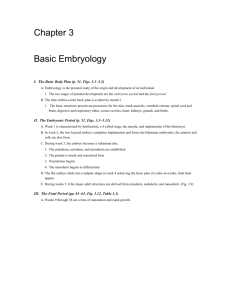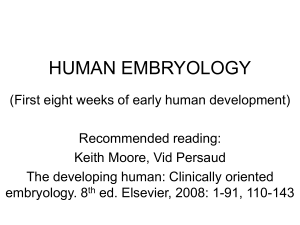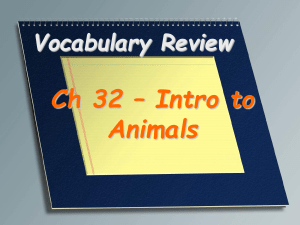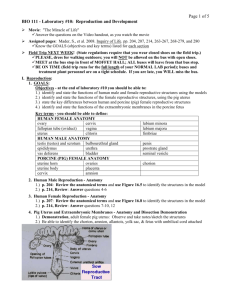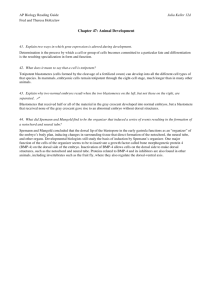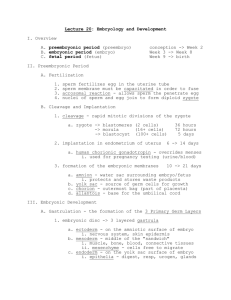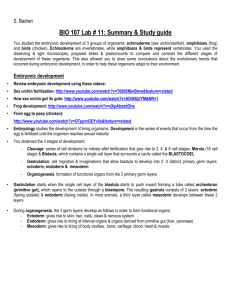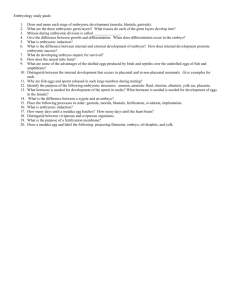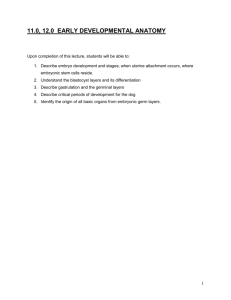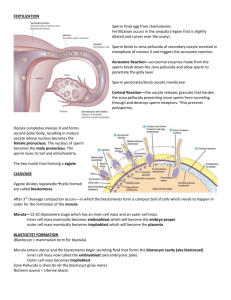AP Bio Chapter 47 – Animal Development
advertisement
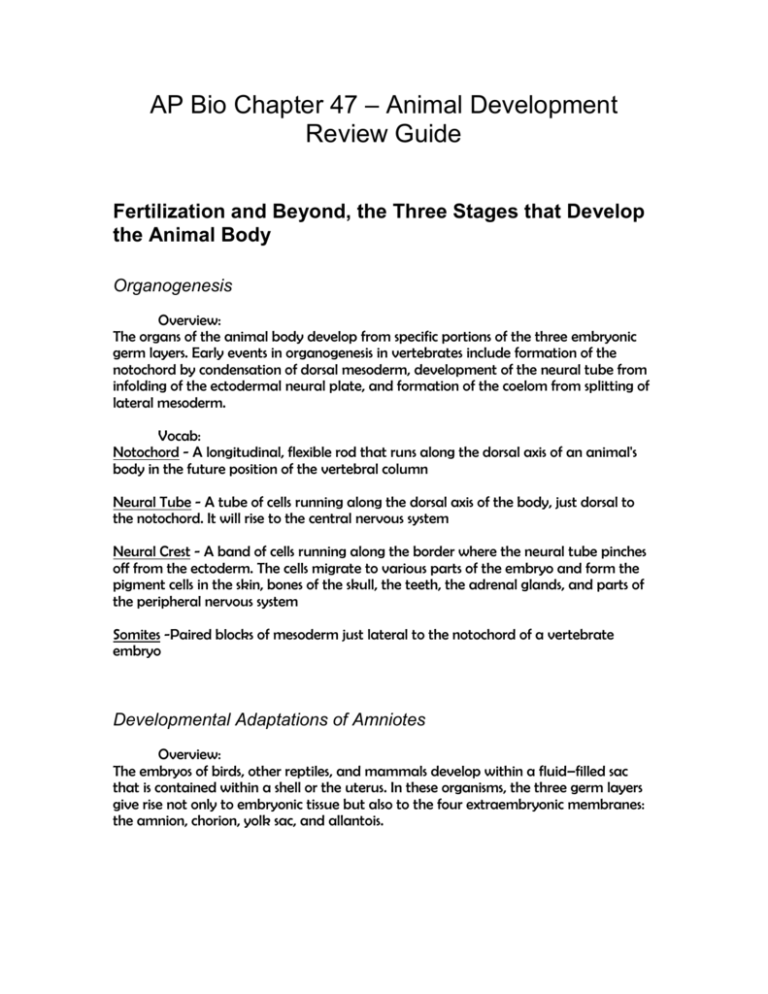
AP Bio Chapter 47 – Animal Development Review Guide Fertilization and Beyond, the Three Stages that Develop the Animal Body Organogenesis Overview: The organs of the animal body develop from specific portions of the three embryonic germ layers. Early events in organogenesis in vertebrates include formation of the notochord by condensation of dorsal mesoderm, development of the neural tube from infolding of the ectodermal neural plate, and formation of the coelom from splitting of lateral mesoderm. Vocab: Notochord - A longitudinal, flexible rod that runs along the dorsal axis of an animal's body in the future position of the vertebral column Neural Tube - A tube of cells running along the dorsal axis of the body, just dorsal to the notochord. It will rise to the central nervous system Neural Crest - A band of cells running along the border where the neural tube pinches off from the ectoderm. The cells migrate to various parts of the embryo and form the pigment cells in the skin, bones of the skull, the teeth, the adrenal glands, and parts of the peripheral nervous system Somites -Paired blocks of mesoderm just lateral to the notochord of a vertebrate embryo Developmental Adaptations of Amniotes Overview: The embryos of birds, other reptiles, and mammals develop within a fluid–filled sac that is contained within a shell or the uterus. In these organisms, the three germ layers give rise not only to embryonic tissue but also to the four extraembryonic membranes: the amnion, chorion, yolk sac, and allantois. Vocab: Amniote - Member of a clade of tetrpods that have an amniotic egg containing specialized membranes that protect the embryo, including mammals and birds and other reptiles Extraembryonic Membranes - Four membranes (yolk sac [1st site of blood cells and circulatory system function], amnion [innermost extraembryonic membrane, encloses a fluid-filled sac in which the embryo is suspended], chorion [contributes to the formation of the mammalian placenta], allantois [serves as a repository for the embryo's nitrogenous waste] ) that support the developing embryo in mammals and birds and other reptiles Mammalian Development Overview: The eggs of placental mammals are small and store few nutrients. They exhibit holoblastic cleavage and show no obvious polarity. Gastrulation and organogenesis, however, resemble the processes in birds and other reptiles. After fertilization and early cleavage in the oviduct, the blastocyst implants in the uterus. The trophoblast initiates formation of the fetal portion of the placenta, and the embryo proper develops from a single layer of cells, the epiblast, within the blastocyst. Extraembryonic membranes homologous to those of birds and other reptiles function in intrauterine development. Vocab: Blastocyst - An embryonic stage in mammals; a hollow ball of cells produced one week after fertilization in humans Inner Cell Mass - A cluster of cells in a mammalian blastocyst that protrudes into one end of the cavity and subsequently develops into the embryo proper and some of the extraembryonic membranes Trophblast - The outer epithelium of the blastocyst, which forms the fetal part of the placenta The Developmental Fate of Cells Fate Mapping Overview: Experimentally derived fate maps of embryos have shown that specific regions of the zygote or blastula develop into specific parts of older embryos. Vocab: Fate Maps - Territorial diagram of embryonic development that reveals the future development of individual cells and tissues. Developmental Potential - The range of structures that it can give rise to Establishing Cellular Asymmetries Overview: In non–amniotic species, unevenly distributed cytoplasmic determinants in the egg cell are important in establishing the body axes and in setting up differences between the blastomeres resulting from cleavage of the zygote. Cells that receive different cytoplasmic determinants undergo different fates. In amniotes, local environmental differences play the major role in establishing initial differences between cells and later the body axes. As embryonic development proceeds, the potency of cells becomes progressively more limited in all species. Vocab: Totipotent - Describing a cell that can give rise to all parts of an organism Cell Fate Determination and Pattern Formation by Inductive Signals Overview: Cells in a developing embryo receive and interpret positional information that varies with location. This information is often in the form of signal molecules secreted by cells in special “organizer” regions of the embryo, such as the dorsal lip of the blastopore in the amphibian gastrula and the AER and ZPA of the vertebrate limb bud. The signal molecules influence gene expression in the cells that receive them, leading to differentiation and the development of particular structures. Vocab: Induction - The switching on of a set of genes that make the receiving cells differentiate into a specific tissues Pattern Formation - The ordering of cells into specific three-dimensional structures, an essential part of shaping an organism and its individual parts during development Positional Information - Signals to which genes regulating development respond, indicating a cell's location relative to other cells in an embryonic structure. Apical Ectodermal Ridge (AER) - A limb-bud organizer region consisting of a thickened area of ectoderm at the tip of a limb bud Zone of Polarizing Activity (ZPA) - A limb-bud organizer region consisting of a block of mesoderm located where the posterior of the bud is attached to the body
